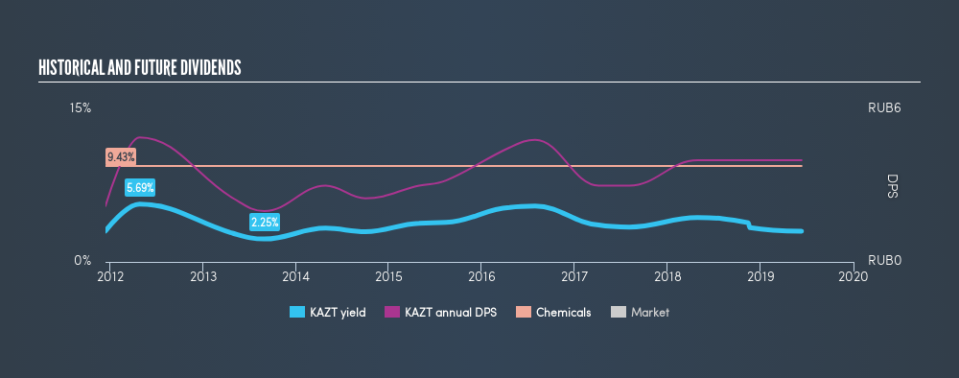Is Public Joint Stock Company KuibyshevAzot (MCX:KAZT) A Smart Pick For Income Investors?

Want to participate in a short research study? Help shape the future of investing tools and you could win a $250 gift card!
Could Public Joint Stock Company KuibyshevAzot (MCX:KAZT) be an attractive dividend share to own for the long haul? Investors are often drawn to strong companies with the idea of reinvesting the dividends. If you are hoping to live on the income from dividends, it's important to be a lot more stringent with your investments than the average punter.
With a goodly-sized dividend yield despite a relatively short payment history, investors might be wondering if KuibyshevAzot is a new dividend aristocrat in the making. We'd agree the yield does look enticing. The company also bought back stock during the year, equivalent to approximately 6.6% of the company's market capitalisation at the time. Some simple research can reduce the risk of buying KuibyshevAzot for its dividend - read on to learn more.
Explore this interactive chart for our latest analysis on KuibyshevAzot!
Payout ratios
Dividends are usually paid out of company earnings. If a company is paying more than it earns, then the dividend might become unsustainable - hardly an ideal situation. Comparing dividend payments to a company's net profit after tax is a simple way of reality-checking whether a dividend is sustainable. Looking at the data, we can see that 10% of KuibyshevAzot's profits were paid out as dividends in the last 12 months. With a low payout ratio, it looks like the dividend is comprehensively covered by earnings.
Another important check we do is to see if the free cash flow generated is sufficient to pay the dividend. KuibyshevAzot's cash payout ratio last year was 18%, which is quite low and suggests that the dividend was thoroughly covered by cash flow. It's positive to see that KuibyshevAzot's dividend is covered by both profits and cash flow, since this is generally a sign that the dividend is sustainable, and a lower payout ratio usually suggests a greater margin of safety before the dividend gets cut.
Consider getting our latest analysis on KuibyshevAzot's financial position here.
Dividend Volatility
Before buying a stock for its income, we want to see if the dividends have been stable in the past, and if the company has a track record of maintaining its dividend. Looking at the data, we can see that KuibyshevAzot has been paying a dividend for the past seven years. It's good to see that KuibyshevAzot has been paying a dividend for a number of years. However, the dividend has been cut at least once in the past, and we're concerned that what has been cut once, could be cut again. During the past seven-year period, the first annual payment was RUруб2.20 in 2012, compared to RUруб4.00 last year. This works out to be a compound annual growth rate (CAGR) of approximately 8.9% a year over that time. The dividends haven't grown at precisely 8.9% every year, but this is a useful way to average out the historical rate of growth.
A reasonable rate of dividend growth is good to see, but we're wary that the dividend history is not as solid as we'd like, having been cut at least once.
Dividend Growth Potential
With a relatively unstable dividend, it's even more important to see if earnings per share (EPS) are growing. Why take the risk of a dividend getting cut, unless there's a good chance of bigger dividends in future? Strong earnings per share (EPS) growth might encourage our interest in the company despite fluctuating dividends, which is why it's great to see KuibyshevAzot has grown its earnings per share at 39% per annum over the past five years. Earnings per share have grown rapidly, and the company is retaining a majority of its earnings. We think this is ideal from an investment perspective, if the company is able to reinvest these earnings effectively.
Conclusion
When we look at a dividend stock, we need to form a judgement on whether the dividend will grow, if the company is able to maintain it in a wide range of economic circumstances, and if the dividend payout is sustainable. First, we like that the company's dividend payments appear well covered, although the retained capital also needs to be effectively reinvested. We were also glad to see it growing earnings, but it was concerning to see the dividend has been cut at least once in the past. All things considered, KuibyshevAzot looks like a strong prospect. At the right valuation, it could be something special.
Are management backing themselves to deliver performance? Check their shareholdings in KuibyshevAzot in our latest insider ownership analysis.
We have also put together a list of global stocks with a market capitalisation above $1bn and yielding more 3%.
We aim to bring you long-term focused research analysis driven by fundamental data. Note that our analysis may not factor in the latest price-sensitive company announcements or qualitative material.
If you spot an error that warrants correction, please contact the editor at editorial-team@simplywallst.com. This article by Simply Wall St is general in nature. It does not constitute a recommendation to buy or sell any stock, and does not take account of your objectives, or your financial situation. Simply Wall St has no position in the stocks mentioned. Thank you for reading.

